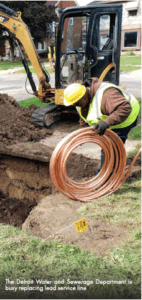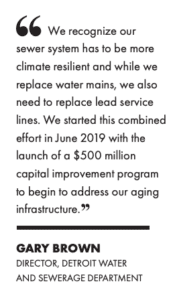Out of Sight, Top of Mind
April 12, 2022By Karen Dybis
 When it comes to Michigan’s aging underground infrastructure, state leaders such Macomb County Public Works Commissioner Candice Miller knows there’s a temptation to ignore the problem.
When it comes to Michigan’s aging underground infrastructure, state leaders such Macomb County Public Works Commissioner Candice Miller knows there’s a temptation to ignore the problem.
But she also knows with visible emergencies from neighborhood sinkholes to Southeast Michigan’s recent flooding to Flint’s lead contaminated drinking water, issues that are out of sight cannot be out of mind.
“There’s such a need that it’s overwhelming. But you can’t look at it that way or it will be overwhelming,” Miller said. “It’s taking a bite of the elephant. You just have to keep eating it. It has to be done.”
UNDERGROUND WORK DEMANDS UPGRADES, COLLABORATION
 Miller and other leaders, including Detroit Water and Sewerage Department Director Gary Brown, agree: The state’s underground infrastructure demands investment, upgrades, and collaboration.
Miller and other leaders, including Detroit Water and Sewerage Department Director Gary Brown, agree: The state’s underground infrastructure demands investment, upgrades, and collaboration.
For example, this spring DWSD will start a $40-million project in the Far West Detroit neighborhood near Rouge Park. The massive project will not only replace water mains and lead service lines, but it will also redirect rain and snowmelt from the neighborhood to two new stormwater detention basins in the park.
“It will create 99 million more gallons of capacity in the combined sewer system that will benefit Detroit and the region, especially during rain events, which is why the Great Lakes Water Authority and the Oakland County Water Resources Commissioner are sharing in the cost,” Brown said.
CREATING A CLIMATE RESILIENT SYSTEM
Accelerating these infrastructure upgrades also is a primary focus, Brown added.
“We recognize our sewer system has to be more climate resilient and while we replace water mains, we also need to replace lead service lines,” Brown said. “We started this combined effort in June 2019 with the launch of a $500 million capital improvement program to begin to address our aging infrastructure.”
Miller also knows what happens when underground infrastructure is ignored, inspections deferred, and investments delayed. She not so fondly recalls the 2016 interceptor sewer pipe collapse, which created a football-field sized sinkhole at 15 Mile near Utica Road in Fraser. The collapse, estimated at $150 million and three years to fix, took under a year and about $70 million, Miller said.
To combat these disasters, Miller established what she called the biggest inspection project of underground structures in Macomb County’s history. County crews also started an extensive grouting program, injecting grout into critical pipes like ones that go under I-94 or the Clinton River. Another project will line these all-important interceptors with an impervious material that will extend the pipe’s life indefinitely.
“Think about what an environmental catastrophe it would be to have a huge issue with raw sewage spilling eventually into Lake St. Clair,” Miller said. “We’re spending a lot of money on (underground infrastructure), but we’ll have to invest more. … I’m not interested in a shortterm fix.”
SPENDING A DIME TO SAVE A DOLLAR
Miller said another huge issue for Southeast Michigan is the combined sewer overflows – the same issue that caused the massive flooding across Wayne County last year. Macomb County is working on reducing its impact, Miller said, but there needs to be more widespread efforts.
“This also is a generational thing. We don’t have to live this way,” Miller said. “I try to do a lot of public education around (underground infrastructure). I am spending a lot of money on this stuff. Sometimes, you have to spend a dime to save a dollar. That’s the way I look at this.”•
Karen Dybis a freelance writer in Metro Detroit.
